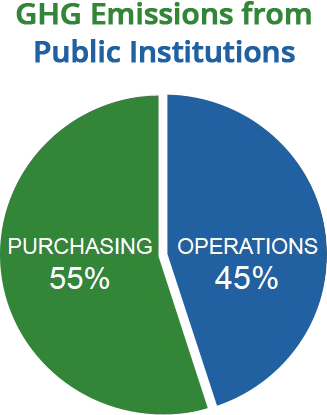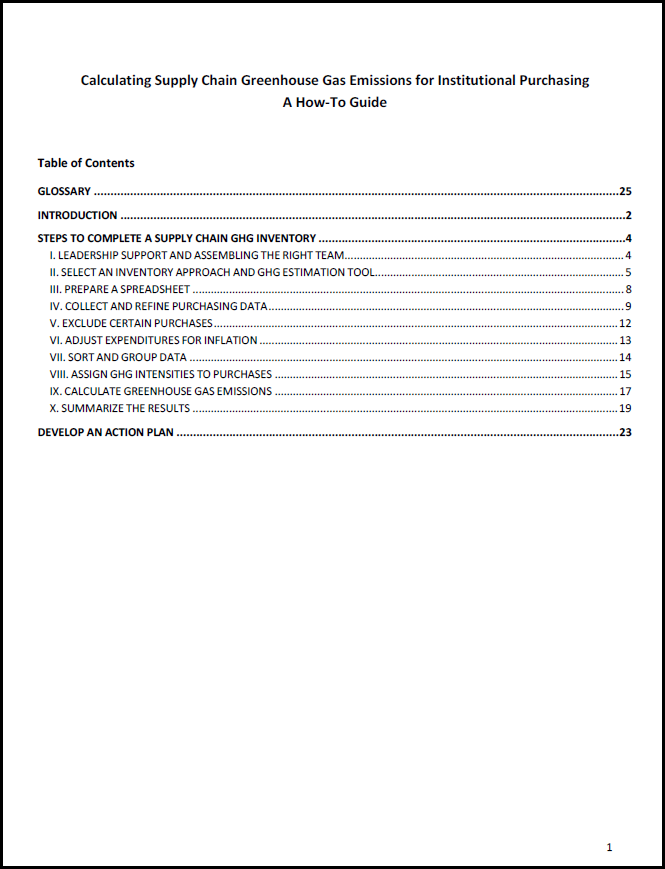Overlooked Emissions
An organization’s supply chain or purchased goods and services, accounts for 35-55% of their entire emissions output. This gives purchasers and their colleagues a huge opportunity to focus on aspects of climate protection efforts that are sometimes overlooked - reducing the climate impacts of purchasing.
Step by Step Guidance
This “How-To” document was created to guide local governments and other institutions through estimating and reporting supply chain GHG emissions. This process will provide you with your institution's supply chain greenhouse gas emissions inventory, also simply called a supply chain emissions inventory. The results of a supply chain emissions inventory may identify high-impact purchasing categories that are not traditionally targeted in most green purchasing programs. Examples of this are construction and information and communication technology (ICT).
How to Begin
You need to conduct a bit of background research to learn about supply chain emissions. You also need to familiarize yourself with web-based tools, and, most important, you need to learn a lot about how purchasing works at your institution. In addition to reducing the climate impacts of purchasing, you need to decide the additional specific objectives of your supply chain emissions inventory. Here are a few you might consider:
- Do you plan on presenting supply chain emissions results to specific vendors to emphasize the importance of reducing their operational emissions and sourcing low-carbon materials?
- Do you want to design and target a training for staff involved in procurement of high-impact products?
- How will the results of the emissions inventory advance climate-friendly purchasing?
- What stakeholders should be involved from the start?
- What will the final product look like?
- Who is the audiences?
These early goals may change throughout the course of the project, but they provide good guideposts to get started.
Setting Priorities
Understanding high-impact purchasing categories can be helpful in identifying possible priorities for action. While it is important to note that the purchase categories with the highest emissions aren’t always the ones with the best opportunities for emissions reduction, they’re always the best place to start looking for immediate opportunities to reduce your emissions.
Example: After you conducting an analysis of your institution's GHG emissions, you may notice construction accounts for the largest portion of your GHG emissions inventory (a core module within this toolkit). However, reducing GHG emissions associated with construction takes technical expertise, and developing relationships with your contractor, which takes time. This would be a great long-term goal, but a better use of resources in the beginning stages would be to tackle more immediate opportunities, like, the procurement of ICT equipment (another core module).
Not all organizations can – or should – do a complete supply chain emissions inventory. These inventories can be time and resource intensive to complete. This toolkit includes the result of a study completed on behalf of the West Coast Climate Forum that is intended to inform organizations unable to compete their own inventory of their likely supply chain impacts, in order to help them prioritize their efforts. See the report here.
The How-To Guide
This “How-To” guide offers a general method for estimating the climate impacts of government purchasing in a step-by-step format. This resource is a guide, not a one-size-fits-all instruction manual. Performing a supply chain emissions inventory will be slightly different for every organization. In addition, the steps described in this Guide are not linear. Some of the steps may happen in parallel; some may be iterative; some may need to be repeated; some may not be necessary for all organizations.
This Guide is primarily based on the experience of and written by Alameda County, California as they completed their first supply chain emissions inventory. Their work was built-on by the West Coast Materials and Climate Management Forum to also capture the experience of other organizations who have completed similar work in an attempt to make this guidance document applicable and accessible to various types and sizes of organizations.
This Guide breaks the supply chain GHG inventory process into 10 steps, provides materials to develop an action plan, and defines important terms within the glossary:
Calculating Supply Chain Greenhouse Gas Emissions for Institutional Purchasing – A How to Guide
- Gain leadership support and assemble the right team for effectively conducting a supply chain analysis.
- Select an inventory approach and tool for estimating supply chain greenhouse gas emissions.
- Prepare an inventory spreadsheet. Preparing the spreadsheet will clarify the inventory process and the data required to calculate supply chain emissions.
- Collect and refine purchasing data (i.e. annual expenditures) in a spreadsheet that includes all your institution’s expenditures in one year, refine it with your institution’s purchasing expert
- Exclude certain purchases that may lead to under an over estimation or double counting of emissions.
- Adjust expenditures for inflation to account for the effect of inflation on the price of goods and services between the year(s) you’re analyzing.
- Sort and group data. Depending on the data set, sorting and grouping can reduce the time required to complete the inventory.
- Assign GHG emission factors (MT CO2e / $1,000,000) by matching purchasing data with sectors in EIOLCA.net (an online tool to estimate GHG emissions from materials, and services acquired).
- Calculate greenhouse gas emissions
- Summarize and present the results to stakeholders, decision makers, and potential collaborators to engage others in the effort to protect the climate through mindful purchasing.
- Develop an Action Plan and utilize newly acquired tools to address your high-impact areas
- Glossary of important terms


